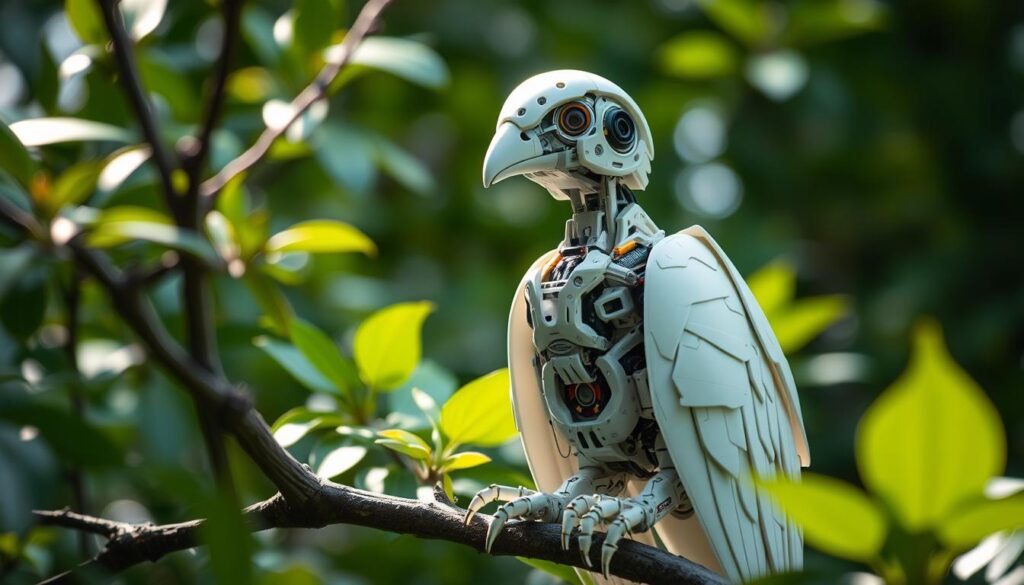Birds that sound like robots have amazed many with their unique calls. These calls remind us of robotic sounds. The Northern Mockingbird and European Starling are birds known for their mechanical sounds. They show us the amazing world of avian automation.

The world of birds that sound like robots is full of interesting calls. From mechanical to robotic sounds, it’s all fascinating. By exploring the science behind these sounds, we can understand their uniqueness. We can also learn about the behavior and characteristics of these birds.
Key Takeaways
- Birds that sound like robots produce unique and intriguing calls
- Robotic bird sounds can be found in various species, such as the Northern Mockingbird and European Starling
- Avian automation is a fascinating topic in the world of ornithology
- The science behind robotic bird sounds is complex and interesting
- Exploring the world of birds that sound like robots can help us learn more about their behavior and characteristics
- Robotic bird sounds are a key aspect of avian automation and can be used to identify different species
The Fascinating World of Mechanical-Sounding Birds
Research shows birds have evolved to make unique sounds to talk to each other. Sometimes, these sounds sound like machines. This has made people more interested in mechanical bird calls and avian automation. It’s amazing how birds can mimic mechanical sounds.
In the bird world, mechanical bird calls are key for communication. They help birds share info about who they are, where they are, and what they want. The variety of these calls shows how diverse bird species are. From simple to complex, avian automation helps birds live in many different places.
- Frequency modulation: Birds use this to make different sounds, from simple tones to complex melodies.
- Syrinx: This is the vocal organ at the base of the trachea that makes sound in birds.
- Beak shape and size: The shape and size of a bird’s beak can change the sound it makes. Some beaks are better for making mechanical sounds.
By looking into mechanical bird calls and avian automation, we can better understand the amazing diversity of bird species. We also learn how they communicate with each other in complex ways.
Birds That Sound Like Robots: A Complete Guide
Many bird species have calls that sound like robots. The Northern Mockingbird and the European Starling are two examples. They can mimic sounds they hear, including mechanical noises, making their calls robotic.
Birds with robotic sounds can learn and mimic new sounds. They have a special vocal organ called the syrinx. This organ lets them make a wide range of sounds, including robotic ones.
Exploring the world of birds that sound like robots shows us the amazing diversity of birds. Learning about these birds and their calls helps us appreciate nature more. It also shows us the incredible abilities of birds that sound like robots.
Here are some key facts about birds that sound like robots:
- Their ability to mimic other sounds, including mechanical noises
- Their complex vocal anatomy, including the syrinx
- Their unique calls, which can sound like they are coming from a robot
The Science Behind Robotic Bird Calls
Have you ever heard a bird call that sounds like a robot? This is not just interesting but also has a scientific reason. The reason lies in the unique anatomy of birds, especially their vocal organ, the syrinx. This organ is at the base of the trachea and makes a wide range of sounds, including mechanical bird sounds.
Studies have found that birds use their syrinx to change their calls. They create sounds that are robotic or electronic-like. This is done by changing the frequency modulation, which lets birds adjust the pitch and tone of their calls. This results in a variety of mechanical bird sounds that are both fascinating and funny.
Syrinx: Nature’s Sound Synthesizer
The syrinx is a complex organ that can make a wide range of sounds. From simple chirps to complex melodies, it’s amazing. Its unique structure lets birds modify sound waves, creating different mechanical bird sounds.
How Birds Create Electronic-Like Sounds
Birds make electronic-like sounds by changing the frequency and amplitude of their calls. They use special muscles and cartilages to control the air flow through the syrinx. This is how they create those unique sounds.
Most Notable Robot-Sounding Birds in North America
North America is home to many bird species, some with notable robot-sounding birds that amaze us. These birds mimic sounds we usually link to technology. This is called avian automation.
The Northern Mockingbird and the American Robin are among the most interesting. They can imitate car alarms, cell phones, and other birds. The Northern Mockingbird is especially known for its wide range of sounds, including whistles and chirps.
Here are some key characteristics of these notable robot-sounding birds:
- Northern Mockingbird: known for its gray and white plumage, distinctive white patches on its wings, and impressive vocal mimicry abilities
- American Robin: recognized by its brown back and red breast, and its ability to mimic a variety of sounds, including other birds and mechanical noises
Studying these birds helps us appreciate the diversity of bird species. Their unique calls are not just fun to hear. They also show us how complex bird communication is and why we need to protect these species.
Remarkable Species Around the World
The variety of bird species is truly amazing. From Australia’s lush forests to Europe’s rolling hills, each place has unique birds. These birds make a wide range of sounds, from simple chirps to complex melodies.
In Australia, the Lyrebird is famous for its mimicry. It can copy robotic bird calls perfectly. In Europe, the Starling can even mimic human speech, creating a beautiful sound. The Asian Koel in Asia has calls that sound like electronics, heard in forests and grasslands.
- Australian Lyrebird: known for its impressive mimicry skills
- European Starling: recognized for its ability to reproduce human speech
- Asian Koel: celebrated for its electronic-like calls
These birds are not just a joy to hear. They also help their ecosystems by showing us how healthy they are.
How to Identify Robot-Like Bird Calls in Your Area
To spot robot-like bird calls, knowing when and how to listen is key. Studies show the best time is early morning. Using recording tools can make it easier to figure out mechanical bird sounds.
Best Times for Listening
The early morning is perfect for hearing bird calls. Birds are usually most active then. Also, listen in the late afternoon or early evening. Some birds are more active during these times.
Recording Equipment Tips
For recording bird calls, the right equipment is essential. A high-quality microphone and recorder are crucial for clear sounds. Birding apps like Audubon Birds and iBird Pro can also help identify robot-like bird calls.

Popular Birding Apps
Many birding apps can aid in identifying mechanical bird sounds. They offer features like audio recordings and identification guides. Audubon Birds and iBird Pro are great options.
The Role of Habitat in Robotic Bird Sounds
Research shows that a bird’s habitat greatly affects its unique calls, including robotic sounds. The environment shapes a bird’s calls, and different habitats lead to different sounds. For example, birds in dense forests might have high-pitched calls to get through the foliage. Birds in open grasslands might have low-pitched calls to travel far.
The role of habitat in robotic bird sounds is key in avian automation. It shows how birds and their environment are connected. By understanding how habitats influence bird calls, we appreciate the diversity of birds and the world of avian automation more. Factors like vegetation, terrain, climate, and predators play a role in robotic bird sounds.
- Vegetation density and type
- Topography and terrain
- Climate and weather patterns
- Predator presence and type
In conclusion, the role of habitat in robotic bird sounds is crucial for understanding avian automation. By studying different habitats and their effects on bird calls, we can better appreciate the diversity of birds and the world of robotic bird sounds.
Conservation Status of These Unique Species
The conservation status of unique species with robotic bird sounds is a big worry. Many of these birds face threats like habitat loss and climate change. Studies show that saving these species means protecting their ecosystems too.
Factors like habitat destruction, fragmentation, and degradation hurt these birds. Climate change also affects their food and breeding. To help, we’re working on saving habitats and promoting green land use.

There are ways to help these amazing birds. Here are a few steps you can take:
- Supporting groups that protect habitats and ecosystems
- Lowering your carbon footprint to fight climate change
- Telling others about the need to save these unique species
Together, we can save these incredible birds and their homes. This way, we can keep their amazing robotic bird sounds alive for future generations.
From birds that sound like robots to animals that glow in the dark, nature is full of mysteries.
Conclusion: Nature’s Own Electronic Musicians
The natural world is full of bird species that sound like robots. These birds that sound like robots and their robotic bird sounds show the amazing diversity and adaptability of birds. From the Australian lyrebird’s electronic trills to the European nightingale’s synthesizer songs, birds have mastered creating unique sounds.
Understanding the science behind these robotic bird sounds helps us see nature’s complexity and ingenuity. Birds use their syrinx, a natural sound synthesizer, to make a wide range of sounds. This ability helps them communicate and survive.
By protecting the habitats of these birds that sound like robots, we can appreciate nature more. Supporting conservation efforts helps these electronic musicians continue to enchant us. Let’s make sure they keep singing for many years to come.
FAQ
What are the most notable robot-sounding bird species in North America?
In North America, the Northern Mockingbird and the American Robin stand out. They have calls that sound like robots or electronics.
How can I identify robot-like bird calls in my local area?
Listen for bird calls early in the morning. Use recording gear to capture sounds. Birding apps can also help identify species by their calls.
What is the role of habitat in the development of robotic bird sounds?
A bird’s habitat shapes its calls, including robotic sounds. Birds adapt their calls to their environment for communication and behavior.
What is the current conservation status of birds that sound like robots?
Birds with robotic calls face threats like habitat loss and climate change. Conservation efforts are key to protect these species and their sounds. Preserving habitats and educating the public are important steps.
How do birds create their robotic-like sounds?
Birds use their syrinx, a sound synthesizer, to make calls. They can mimic electronic sounds through frequency modulation.
What are some examples of robot-sounding bird species around the world?
Around the world, birds like the Australian Lyrebird and the European Starling are known for their robotic calls. These birds can mimic a wide range of sounds.
